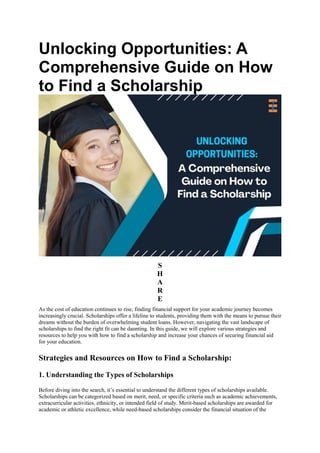Introduction:
Embarking on the journey to higher education is a significant milestone, and for many students, scholarships play a crucial role in making this dream a reality. The competitive nature of scholarship applications requires a strategic and thoughtful approach to stand out among the pool of applicants. In this comprehensive guide, we’ll explore effective strategies to supercharge your college scholarship applications and increase your chances of securing valuable financial support for your education.
- Research Exhaustively:
a. Explore Diverse Opportunities: Cast a wide net when searching for scholarships. Investigate local, national, and niche opportunities to maximize your chances of finding scholarships that align with your goals, interests, and background.
b. Understand Eligibility Criteria: Carefully review the eligibility criteria for each scholarship. Tailor your applications to scholarships where you meet the specified requirements, increasing your chances of being shortlisted.
- Create a Scholarship Portfolio:
a. Gather Documents in Advance: Compile essential documents such as transcripts, letters of recommendation, and personal statements early on. Having these materials readily available streamlines the application process and allows you to focus on crafting compelling narratives.
b. Build a Resume: Develop a comprehensive resume that highlights your academic achievements, extracurricular activities, volunteer work, and any relevant experiences. This document serves as a snapshot of your accomplishments and can be adapted for various applications.
- Craft Compelling Personal Statements:
a. Tell Your Story: Use personal statements to narrate your unique story. Discuss challenges you’ve overcome, your passion for your chosen field of study, and your future goals. Make sure your voice resonates authentically.
b. Address the Scholarship Prompt: Tailor each personal statement to the specific prompts outlined in the scholarship application. Ensure that your responses directly address the criteria set by the scholarship committee.
- Request Thoughtful Letters of Recommendation:
a. Choose Recommenders Wisely: Select individuals who know you well and can speak to your character, achievements, and potential. This might include teachers, mentors, or employers who can provide specific examples of your abilities.
b. Provide Guidance: When requesting letters of recommendation, provide your recommenders with information about your academic and extracurricular achievements, goals, and the specific scholarship criteria. This helps them tailor their letters to the scholarship requirements.
- Demonstrate Impact through Extracurricular Activities:
a. Quality Over Quantity: Focus on showcasing a few meaningful extracurricular activities rather than listing a plethora of activities. Highlight your leadership roles, achievements, and the positive impact you’ve made in these pursuits.
b. Connect Activities to Your Goals: Demonstrate how your extracurricular activities align with your academic and career goals. Illustrate how these experiences have shaped your character, skills, and commitment to making a difference.
- Seek Feedback on Your Application:
a. Peer Review: Share your scholarship application drafts with teachers, mentors, or peers for constructive feedback. External perspectives can provide valuable insights and help you refine your application before submission.
b. Edit and Revise: Take the time to carefully edit and revise your application. Ensure clarity, coherence, and adherence to the guidelines. A polished application reflects your commitment to the scholarship opportunity.
- Meet Deadlines and Stay Organized:
a. Create a Calendar: Use a calendar or planner to track scholarship application deadlines. Create a schedule for completing various components of each application to avoid last-minute stress and ensure thoroughness.
b. Double-Check Requirements: Before submitting each application, double-check that you’ve met all the requirements. Missing a crucial document or overlooking a specific guideline can be the difference between acceptance and rejection.
- Follow Up After Submission:
a. Express Gratitude: Send a thank-you email or note to your recommenders and anyone who assisted you in the application process. Express your gratitude for their support and let them know about your progress.
b. Prepare for Interviews: If the scholarship process involves interviews, prepare by researching common interview questions and practicing your responses. Showcase your passion, achievements, and commitment to your education and future goals.
Conclusion:
Supercharging your college scholarship applications requires a combination of thorough research, thoughtful preparation, and authentic storytelling. By diligently crafting compelling personal statements, showcasing your achievements through a well-rounded scholarship portfolio, and meeting all application requirements, you increase your chances of standing out to scholarship committees. Remember, each application is an opportunity to convey your unique qualities and aspirations, so approach the process with dedication, resilience, and a genuine passion for your educational journey. Good luck






